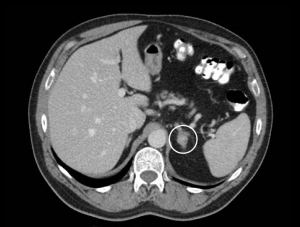-
Where are the adrenal glands?
-
What do the adrenal glands do?
-
Cortex
-
Medulla
-
How do adrenal diseases present?
-
How are adrenal diseases investigated and treated?
-
How are adrenal glands removed?
Where are the adrenal glands?
They are a paired organ. Each adrenal glands lies on top of the kidney, at the back of the abdomen. Each gland is about 3 x 1cm.
What do the adrenal glands do?
There are two distinct parts to the adrenal gland – the cortex and medulla. Whilst the functions of the cortex and medulla are independent, it is impossible for a surgeon to separate the two.
Cortex
The function of the adrenal cortex is to make steroids for the regulation of glucose metabolism (glucocorticoids), salt balance (mineralocorticoids) and male sex hormones (androgens).
Medulla
The adrenal medulla manufactures adrenaline and noradrenaline (catecholamines).
How do adrenal diseases present?
Either by overproduction of one of the products of the adrenal gland, or as an incidental finding of an adrenal tumour during an ultrasound or CT/MRI scan. Most diseases are benign, but the chance of cancer increases with larger tumours (over 6cm).
The different diseases are:
Excess glucocorticoid – Cushing’s syndrome
Excess mineralocorticoid – Conn’s syndrome
Excess androgens – Virilising symptoms
Excess catecholamines – Phaeochromocytoma
Incidental finding – ‘Incidentaloma’
How are adrenal diseases investigated and treated?
All patients with adrenal disease should be seen by an endocrinologist in a centre of excellence. The first step is to extensively test for the abnormal production of steroids and catecholamines. Patients may then require medication to stabilise the disease. Many (but by no means all) adrenal tumours require surgery. Incidentalomas greater than 4cm in diameter should be removed.
How are adrenal glands removed?
For tumours upto 5cm in diameter, the gold standard surgical approach is a laparoscopic adrenalectomy. For larger tumours, or whenever there is concern about malignancy, the tumour is removed by open surgery. One can lead a normal life without one adrenal gland. When both adrenal glands have to be removed, patients require to take steroid replacement for life.
